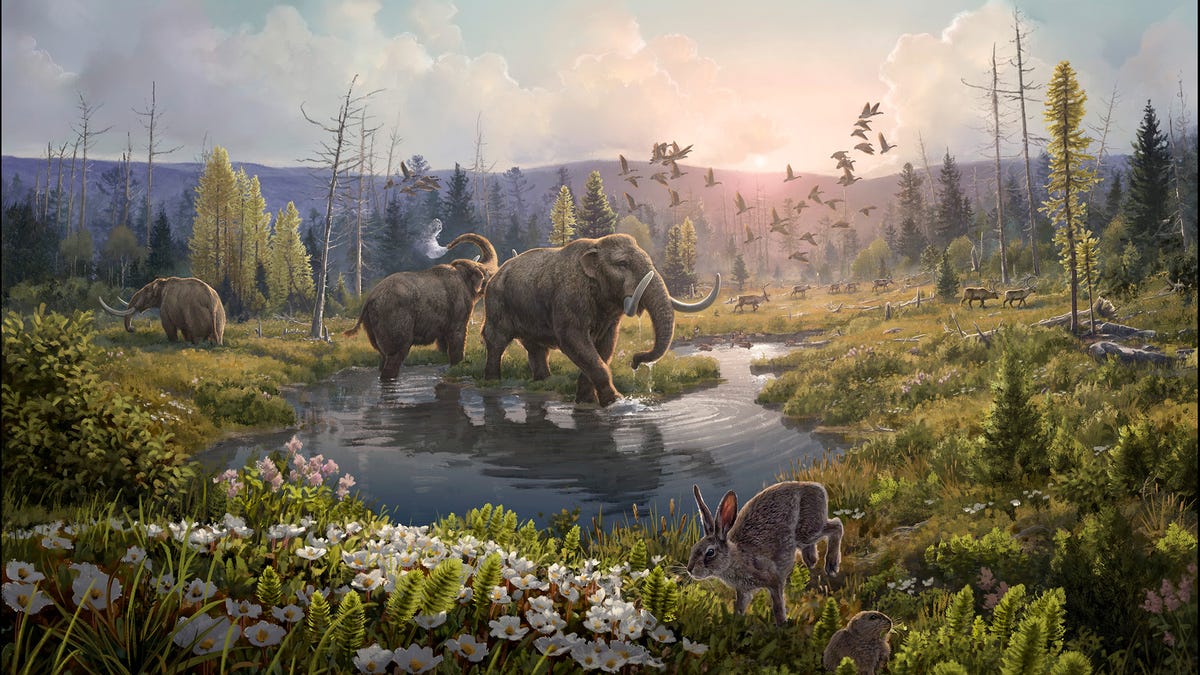Technologies
2 Million-Year-Old DNA, the Oldest Ever Recovered, Opens Window to the Past
The prehistoric forest of northern Greenland was home to mastodons, reindeer, hares and an abundance of plant life.

As early as 2006, Eske Willerslev and members of his lab ventured into northern Greenland with a drill, extracting cores of sediment from the Kap København Formation. They were hunting for environmental DNA, or eDNA, in their cores — puzzle pieces that could help paint a picture of the plants and animals present in the region 2 million years ago.
But for the longest time, they came up empty-handed. «Every time we had improvements in terms of DNA extraction or sequencing technology, we’d revisit these samples,» Willerslev, an evolutionary geneticist at the University of Cambridge, said in a press briefing on Tuesday.
No matter what, the researchers failed to get what they were looking for. The run of bad luck saw members of the lab turn to the occult for an explanation; they named their troubles «the curse of the Kap København Formation.»
But with steady improvements in DNA extraction and sequencing technologies, the curse was finally broken.
On Wednesday, the team published the results of their 16-year pursuit of ancient DNA in the journal Nature. They were able to sequence eDNA from 41 sediment samples, collected in 2006, 2012 and 2016 from the Kap København Formation and undisturbed by humans for 2 million years. Their analyses revealed that a lush forest replete with reindeer, hares, mastodons and a wide variety of flora once stood in what is now a dull, gray polar desert.
Willerslev, a pioneering geneticist who has previously recovered eDNA from ice cores and shown it could survive in glaciers, noted that the «breakthrough» relied on expertise, advances in genetic sequencing techniques and bioinformatics.
History in the soil
DNA, which carries the instructions for life, is not a particularly sturdy molecule. The bonds that hold it together are weak and, over time, they break down.
This is why, even though we have an abundance of dinosaur fossils, we don’t have any dinosaur DNA. The beasts died out 66 million years ago, and the DNA would simply not survive that long.
When DNA degrades, the once-long strands of information break apart into smaller and smaller pieces. It becomes almost impossible to piece these fragments back together in the right configuration, especially if they are mixed in with a lot of other DNA from the environment.
Think of DNA like a book. Let’s say Alice in Wonderland. If you have the whole book, you can understand the story. But if you’re missing a few pages, you might not understand where the White Rabbit came from or why Alice ended up at a tea party with the Mad Hatter. If you’re missing lots of pages, you probably can’t even tell what the story was to begin with. Alice? Who’s that? And why is she 10 feet tall?
That’s the problem working with ancient DNA. You might be able to retrieve small fragments of DNA but it is generally too fragmented to be able to tell where it came from — and certainly too fragmented to understand where it came from.
But under certain circumstances, DNA fragments can survive deep time.
«The ‘survival time’ of DNA in the environment is incredibly variable and strongly dependent on the environment itself,» notes Michael Knapp, an ecologist and geneticist at Otago University in New Zealand.
Previously, the oldest DNA ever recovered came from mammoth fossils found in the Siberian permafrost. In a Nature paper in 2021, researchers showed that DNA from the mammoth teeth was, potentially, about 1.6 million years old. The DNA recovered was broken up into small fragments but they weren’t degraded so much they couldn’t be pieced back together. The cold temperature of the permafrost certainly helped with this.
It’s a similar story in the new study.
Willerslev and his collaborators postulate that the long survival time of the DNA in their sediment cores was possible for two reasons. The first is the constant cold temperature of the polar desert. The second is the way the DNA is bound to minerals in the cores, preventing degradation over longer time scales. The idea is that these mineral surfaces prevent enzymes from breaking down the DNA.
Karina Sand, a geochemist at the University of Copenhagen and co-author on the paper, explained that one of the technological leaps that enabled this feat was extracting DNA from clay and quartz minerals. The latter provided an abundance of DNA, but the former was harder to extract good DNA from. Fortunately, that leaves the door open for even older DNA extraction.
«If we can get better at extracting the DNA from the clay minerals, then we think we can go further back in time with DNA,» she said.
The research team was able to extract DNA from the sediment cores and begin to read the surviving fragments. These fragments were then compared to a database of genomes (complete DNA sequences) of modern plants and animals, looking for DNA matches. Over time, they were able to fill the blank pages of history, demonstrating the thriving ecosystem of ancient Greenland.
The ancient forest of Greenland
Two million years ago, Greenland was a different place.
«The Kap København ecosystem, which has no present-day equivalent, existed at considerably higher temperatures than we have today,» noted Mikkel Pederson, a geneticist at the Lundbeck Foundation GeoGenetics Centre, in a press release.
In northern Greenland, average temperatures during this time were likely more than 11 degrees Celsius (around 20 degrees Fahrenheit) higher than they are today. Previous studies at Kap København have shown evidence it was home to a boreal forest, but the eDNA extracted and analyzed in the new study provides a complete reimagining of the area, adding in megafauna and a wide variety of plant life.
The headline mammal DNA found in the cores is undoubtedly the mastodon — which is having a bit of a moment thanks to social media. Some of the eDNA found matched to the Elephantidae family, which includes elephants, mammoths and mastodons. It seems mastodons may have roamed Greenland 2 million years ago, though the researchers note the evidence isn’t extremely strong and is based on relatively weak DNA matches.
The team also found DNA related to reindeer, hares and rabbits, and the subfamily of animals that includes lemmings, voles and muskrats. Notably absent, however, is DNA from carnivores. The researchers suggest this is because of their comparably small biomass in relation to the herbivores. «It’s basically a numbers game,» Willerslev said.
One of the more intriguing DNA finds is of the Atlantic horseshoe crab. The species is no longer found at such northern latitudes, and the authors suggest this may mean Kap København experienced warmer sea surface temperatures 2 million years ago. Previous research has suggested the sea surface was warmer at higher latitudes, and the discovery of horseshoe crab DNA lends further support to this hypothesis.
Warmer temperatures are key. Multiple authors on the paper have reiterated the importance of understanding an ecosystem like this, given the effects of global warming. Two million years ago, the climate was changing and the eDNA shows that Arctic species were living with species that loved much warmer climes. This helps scientists to get an understanding of how nature was adapting to those changes and, within the DNA signatures, there may be clues to ways we could help modern-day fauna and flora survive extreme climatic swings.
One of the significant limitations of studying eDNA is that scientists have to postulate about the kinds of species that were living at the time. Knapp notes closely related ancient species might give you a DNA match but this is «somewhat inaccurate» — it provides an approximation of what existed. We may only be able to assign the DNA at a family or order level, so we can’t know exactly what roamed the boreal forest of Greenland 2 million years ago.
Even so, the recovery of DNA this old opens a new window to the prehistoric Earth, a pathway for scientists and researchers to probe the ecosystems that existed long before humans were around. The team will head to northern Canada to extract cores next year and hope to go even further back in time.
The extraction method may even lend itself to finding DNA in more humid climates across the world, like in Africa and Australia.
«If we can begin to explore ancient DNA in clay grains from Africa, we may be able to gather ground-breaking information about the origin of many different species —perhaps even new knowledge about the first humans and their ancestors,» Willerslev said in a statement.
«The possibilities are endless.»
Technologies
Apple Desperately Needs to Launch a Foldable iPhone Flip Next Year
Commentary: Apple is the only major phone company without a folding phone. That needs to change in 2026.

Apple’s iPhone 17 came and went and while we certainly love the iPhone 17 Pro and its vibrant cosmic orange color, I can’t help but be disappointed that the long-rumored foldable iPhone Flip wasn’t part of the company’s September launch event. Most Android phone-makers, including Samsung, Google, Motorola, OnePlus, Xiaomi and Honor are multiple generations into their own folding phone lineups, and it’s beginning to feel like Apple is late to the party. That might be a problem.
Apple dominates in the premium phone category, but foldables — which fit into the premium space in terms of price — are already nipping at its heels, with Motorola telling CNET that 20% of customers buying its Razr foldable jumped ship from Apple. Meanwhile, Samsung is in the seventh generation of its Flip and Fold series. As Lisa Eadicicco discovered during a visit to Seoul, «foldables are everywhere» in Samsung’s home country of South Korea.
With nearly every major Android phone-maker entering the foldable market, Apple risks losing potential customers. It also runs the risk of letting a rival like Samsung become the go-to name for foldables, which could make it harder for Apple to make an impact if it eventually launches its own device. Furthermore, early adopters drawn to foldable tech may be too entrenched in the Android ecosystem by the time Apple’s phone arrives to want to switch to iOS.
Apple is unlikely to be worried. It’s estimated that around 20 million foldables from all manufacturers were sold worldwide in 2023, while Apple reportedly sold 26.5 million iPhone 14 Pro Max handsets in the first half of that year alone. In 2024, foldable sales were flat — and 2025 isn’t fairing much better, according to analysts at CounterPoint Research, although Samsung did report record numbers of preorders for its latest foldable. Clearly, Apple feels it has yet to miss the boat.
Apple has always found success in biding its time, observing the industry and launching its own take on a product when it’s ready. Apple didn’t invent phones, tablets, smartwatches or computers, but it found ways to take existing products and make them more useful, more valuable in day-to-day life and — dare I say — more exciting. It’s why the iPhone, iPad, Apple Watch and Mac lines dominate the market today.
For me, I need to see Apple’s take on the foldable phone. I’ve written before about how disappointed I am in foldables. I’ve been a mobile reporter for over 14 years and phones have become increasingly dull as they’ve converged to become slight variations on the same rectangular slab.
Read more: Best Flip Phone for 2025
Foldables promised something new, something innovative, something that briefly sparked some excitement in me, but several years in, that excitement has dwindled to the point of being extinguished. They are fine products and while I like the novelty of a screen that bends, they’re not a revolution in how we interact with our phones. Not in the way that the arrival of the touchscreen was when we were still pushing buttons to type out texts.
I did hope that Google’s Pixel Fold would be the phone to catapult the foldable forward, and while the recent Pixel 10 Pro Fold — the second generation of Google’s foldable — does offer some great updates, it still doesn’t offer any kind of revolution. Instead, it feels more like a «me too» move from Google. Ditto for the OnePlus Open. So I’m left instead to look toward Apple, a company with a track record for product revolutions, to create a new take on the genre that genuinely drives forward how we use our phones.
That innovation won’t just come from the product design. Apple works closely with its third-party software developers, and it’s that input that would help a folding iPhone become genuinely useful. My biggest complaint around foldables right now is that while the hardware is decent, the devices are essentially just running standard versions of Android with a handful of UI tweaks thrown in. They’re regular phones that just happen to bend.
Few Android developers are embracing the folding format, and it’s not difficult to see why; the users aren’t there in sufficient numbers yet to justify the time and expense to adapt their software across a variety of screen sizes. The multiple folding formats already available mean Android foldables face the same fragmentation issue that has plagued the platform since the beginning. Android-based foldables are simply a more difficult platform for developers to build for than regular phones. Apple would be able to change that, as it proved with the iPhone and iPad.
Given Apple’s close relationships with top-tier developers — not to mention its own vast developer team — I expect an eventual Apple foldable to offer innovations that make it more than just an iPhone that folds in half.
And I truly hope it does. I want to look forward to tech launches again. I want to feel excited to get a new gadget in my hands and feel that «wow» moment as I do something transformative for the first time.
In short, I don’t want to be bored by technology anymore. Apple, it’s over to you.
Technologies
Today’s NYT Connections: Sports Edition Hints and Answers for Nov. 27, #430
Here are hints and the answers for the NYT Connections: Sports Edition puzzle for Nov. 27, No. 430.

Looking for the most recent regular Connections answers? Click here for today’s Connections hints, as well as our daily answers and hints for The New York Times Mini Crossword, Wordle and Strands puzzles.
Fittingly, today’s Thanksgiving Day Connections: Sports Edition is mostly about football (although the yellow category covers all sports, really). If you’re struggling with today’s puzzle but still want to solve it, read on for hints and the answers.
Connections: Sports Edition is published by The Athletic, the subscription-based sports journalism site owned by The Times. It doesn’t appear in the NYT Games app, but it does in The Athletic’s own app. Or you can play it for free online.
Read more: NYT Connections: Sports Edition Puzzle Comes Out of Beta
Hints for today’s Connections: Sports Edition groups
Here are four hints for the groupings in today’s Connections: Sports Edition puzzle, ranked from the easiest yellow group to the tough (and sometimes bizarre) purple group.
Yellow group hint: Grab some points.
Green group hint: Pass the turkey.
Blue group hint: Face your big rival.
Purple group hint: Playing with letters in team names.
Answers for today’s Connections: Sports Edition groups
Yellow group: Places where one scores.
Green group: Associated with the NFL on Thanksgiving.
Blue group: College football rivalry «cups.»
Purple group: NFL teams, with the first letter changed.
Read more: Wordle Cheat Sheet: Here Are the Most Popular Letters Used in English Words
What are today’s Connections: Sports Edition answers?
The yellow words in today’s Connections
The theme is places where one scores. The four answers are end zone, goal, hoop and plate.
The green words in today’s Connections
The theme is associated with the NFL on Thanksgiving. The four answers are Cowboys, Lions, Madden and Turducken.
The blue words in today’s Connections
The theme is college football rivalry «cups.» The four answers are Apple, Commonwealth, Governor’s and Territorial.
The purple words in today’s Connections
The theme is NFL teams, with the first letter changed. The four answers are fills (Bills), Mets (Jets), pears (Bears) and yams (Rams).
Technologies
Today’s NYT Mini Crossword Answers for Thursday, Nov. 27
Here are the answers for The New York Times Mini Crossword for Nov. 27.

Looking for the most recent Mini Crossword answer? Click here for today’s Mini Crossword hints, as well as our daily answers and hints for The New York Times Wordle, Strands, Connections and Connections: Sports Edition puzzles.
It’s Thanksgiving, but I wasn’t too thankful for today’s Mini Crossword. It took me nearly four minutes to solve and has some very tricky clues. Read on for the answers. And if you could use some hints and guidance for daily solving, check out our Mini Crossword tips.
If you’re looking for today’s Wordle, Connections, Connections: Sports Edition and Strands answers, you can visit CNET’s NYT puzzle hints page.
Read more: Tips and Tricks for Solving The New York Times Mini Crossword
Let’s get to those Mini Crossword clues and answers.
Mini across clues and answers
1A clue: Enjoyed a Thanksgiving meal
Answer: FEASTED
8A clue: Back half of a GOAT?
Answer: ALLTIME
9A clue: Sudden urge
Answer: IMPULSE
10A clue: Santa’s landing place
Answer: ROOF
11A clue: Abstain from eating
Answer: FAST
15A clue: Tough guy
Answer: BRUISER
18A clue: Ready to use without further assembly
Answer: TURNKEY
19A clue: Some pieces of [circled letters] at the Thanksgiving table
Answer: WINGS
Mini down clues and answers
1D clue: Inside the foul line, in baseball
Answer: FAIR
2D clue: Furry monster with a falsetto
Answer: ELMO
3D clue: Pet food brand
Answer: ALPO
4D clue: Thanksgiving side dish that can fill the [circled letters]
Answer: STUFFING
5D clue: Shop ___ you drop
Answer: TIL
6D clue: M M M M
Answer: EMS
7D clue: Billy ___ Williams, actor who played Lando Calrissian in «Star Wars»
Answer: DEE
12D clue: Requests
Answer: ASKS
13D clue: «Get what I’m saying?»
Answer: SEE
14D clue: Give it a go
Answer: TRY
15D clue: «I should mention …,» for short
Answer: BTW
16D clue: N.B.A. power forward ___ Hachimura
Answer: RUI
17D clue: Large coffee dispenser
Answer: URN
-

 Technologies3 года ago
Technologies3 года agoTech Companies Need to Be Held Accountable for Security, Experts Say
-

 Technologies3 года ago
Technologies3 года agoBest Handheld Game Console in 2023
-

 Technologies3 года ago
Technologies3 года agoTighten Up Your VR Game With the Best Head Straps for Quest 2
-

 Technologies4 года ago
Technologies4 года agoBlack Friday 2021: The best deals on TVs, headphones, kitchenware, and more
-

 Technologies4 года ago
Technologies4 года agoVerum, Wickr and Threema: next generation secured messengers
-

 Technologies4 года ago
Technologies4 года agoGoogle to require vaccinations as Silicon Valley rethinks return-to-office policies
-

 Technologies4 года ago
Technologies4 года agoOlivia Harlan Dekker for Verum Messenger
-

 Technologies4 года ago
Technologies4 года agoiPhone 13 event: How to watch Apple’s big announcement tomorrow
